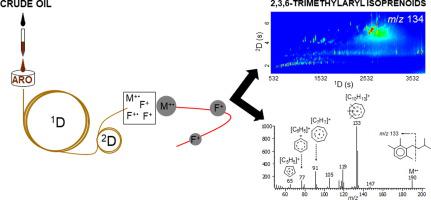当前位置:
X-MOL 学术
›
Org. Geochem.
›
论文详情
Our official English website, www.x-mol.net, welcomes your
feedback! (Note: you will need to create a separate account there.)
Biomarkers of photosynthetic sulfur bacteria in Lower Cretaceous crude oils, East Brazilian marginal basin
Organic Geochemistry ( IF 2.6 ) Pub Date : 2020-10-01 , DOI: 10.1016/j.orggeochem.2020.104083 Bruno Q. Araújo , Vinícius B. Pereira , Francisco R. Aquino Neto , Débora A. Azevedo
Organic Geochemistry ( IF 2.6 ) Pub Date : 2020-10-01 , DOI: 10.1016/j.orggeochem.2020.104083 Bruno Q. Araújo , Vinícius B. Pereira , Francisco R. Aquino Neto , Débora A. Azevedo

|
Abstract Diagenetic aromatic carotenoids and degradation products, which are derived from the carotenoids of photosynthetic sulfur bacteria, were characterized in the aromatic fraction of Brazilian Cretaceous crude oils (NE Brazil, Sergipe-Alagoas Basin) by high-temperature comprehensive two-dimensional gas chromatography coupled to time-of-flight mass spectrometry (HT-GC × GC–TOFMS). Unresolved complex mixtures (UCM), coeluting compounds, and limited mass spectrometric identification were noted by traditional one-dimensional (1D) GC–MS screening of aromatic compounds. Group-type separation on a two-dimensional chromatographic plane, first- and second-dimension retention times (1tR and 2tR, respectively), and mass spectra enabled the assignment of alkylated mono-, di-, tri-, and tetra-aryl hydrocarbons with confidence. A series of diagenetic C40 carotenoids and degraded products, which are likely indicators for green-brown sulfur bacteria, were detected. This finding corroborates previous results, and isorenieratane was relatively more abundant than 2,3,6-trimethylaryl isoprenoids. Moreover, atropisomeric biphenyls (m/z 237), which coeluted using 1D GC–MS analyses, were resolved by GC × GC and identified by mass spectrometry. The identification of minor abundances of chlorobactane, diagenetic biphenyl chlorobactane, and related compounds, for the first time in these Brazilian Cretaceous oils, may indicate a contribution of green sulfur bacteria (Chlorobiaceae) and photic zone euxinia in shallow waters.
中文翻译:

巴西东部边缘盆地下白垩统原油中光合硫细菌的生物标志物
摘要 利用高温综合二维气相色谱法对巴西白垩系原油(巴西东北部,塞尔吉佩-阿拉戈斯盆地)的芳香烃馏分中的光合硫细菌类胡萝卜素衍生的成岩芳香类胡萝卜素及其降解产物进行了表征。飞行时间质谱(HT-GC × GC-TOFMS)。芳香族化合物的传统一维 (1D) GC-MS 筛选发现了未解析的复杂混合物 (UCM)、共流出化合物和有限的质谱鉴定。二维色谱平面上的基团型分离、一维和二维保留时间(分别为 1tR 和 2tR)和质谱实现了烷基化单、二、三和四芳基烃的归属有信心。检测到一系列成岩 C40 类胡萝卜素和降解产物,它们可能是绿褐色硫细菌的指标。这一发现证实了之前的结果,异戊二烯比 2,3,6-三甲基芳基异戊二烯相对更丰富。此外,使用一维 GC-MS 分析共洗脱的阻转异构联苯 (m/z 237) 通过 GC × GC 进行分离并通过质谱法进行鉴定。在这些巴西白垩纪石油中首次发现少量丰度的氯丁烷、成岩联苯氯丁烷和相关化合物,这可能表明绿色硫细菌(Chlorobiaceae)和光区euxinia 在浅水中的贡献。异戊二烯比 2,3,6-三甲基芳基异戊二烯相对更丰富。此外,使用一维 GC-MS 分析共洗脱的阻转异构联苯 (m/z 237) 通过 GC × GC 进行分离并通过质谱法进行鉴定。首次在这些巴西白垩纪石油中鉴定出少量丰度的氯丁烷、成岩联苯氯丁烷和相关化合物,这可能表明浅水区绿色硫细菌(绿藻科)和光带富氧菌的贡献。异戊二烯比 2,3,6-三甲基芳基异戊二烯相对更丰富。此外,使用一维 GC-MS 分析共洗脱的阻转异构联苯 (m/z 237) 通过 GC × GC 进行分离并通过质谱法进行鉴定。首次在这些巴西白垩纪石油中鉴定出少量丰度的氯丁烷、成岩联苯氯丁烷和相关化合物,这可能表明浅水区绿色硫细菌(绿藻科)和光带富氧菌的贡献。
更新日期:2020-10-01
中文翻译:

巴西东部边缘盆地下白垩统原油中光合硫细菌的生物标志物
摘要 利用高温综合二维气相色谱法对巴西白垩系原油(巴西东北部,塞尔吉佩-阿拉戈斯盆地)的芳香烃馏分中的光合硫细菌类胡萝卜素衍生的成岩芳香类胡萝卜素及其降解产物进行了表征。飞行时间质谱(HT-GC × GC-TOFMS)。芳香族化合物的传统一维 (1D) GC-MS 筛选发现了未解析的复杂混合物 (UCM)、共流出化合物和有限的质谱鉴定。二维色谱平面上的基团型分离、一维和二维保留时间(分别为 1tR 和 2tR)和质谱实现了烷基化单、二、三和四芳基烃的归属有信心。检测到一系列成岩 C40 类胡萝卜素和降解产物,它们可能是绿褐色硫细菌的指标。这一发现证实了之前的结果,异戊二烯比 2,3,6-三甲基芳基异戊二烯相对更丰富。此外,使用一维 GC-MS 分析共洗脱的阻转异构联苯 (m/z 237) 通过 GC × GC 进行分离并通过质谱法进行鉴定。在这些巴西白垩纪石油中首次发现少量丰度的氯丁烷、成岩联苯氯丁烷和相关化合物,这可能表明绿色硫细菌(Chlorobiaceae)和光区euxinia 在浅水中的贡献。异戊二烯比 2,3,6-三甲基芳基异戊二烯相对更丰富。此外,使用一维 GC-MS 分析共洗脱的阻转异构联苯 (m/z 237) 通过 GC × GC 进行分离并通过质谱法进行鉴定。首次在这些巴西白垩纪石油中鉴定出少量丰度的氯丁烷、成岩联苯氯丁烷和相关化合物,这可能表明浅水区绿色硫细菌(绿藻科)和光带富氧菌的贡献。异戊二烯比 2,3,6-三甲基芳基异戊二烯相对更丰富。此外,使用一维 GC-MS 分析共洗脱的阻转异构联苯 (m/z 237) 通过 GC × GC 进行分离并通过质谱法进行鉴定。首次在这些巴西白垩纪石油中鉴定出少量丰度的氯丁烷、成岩联苯氯丁烷和相关化合物,这可能表明浅水区绿色硫细菌(绿藻科)和光带富氧菌的贡献。











































 京公网安备 11010802027423号
京公网安备 11010802027423号